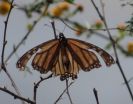(Press-News.org) ALBANY, Calif.—A team of more than a dozen scientists from the U.S. Forest Service's Pacific Southwest (PSW) and Pacific Northwest research stations, universities and Region 5 Ecology Program recently released a synthesis of relevant science that will help inform forest managers as they revise plans for the national forests in the Sierra Nevada and southern Cascades of California. The three most southern national forests in the Sierra Nevada—Inyo, Sequoia and Sierra—will be among the first of the 155 national forests to update their management plans. The new planning rule requires the forests to consider the best available science and encourages a more active role for research in plan development.
At the request of Region 5 leadership and stakeholders, the team embarked on a year-long effort to summarize and integrate recent scientific advances across key topics including forest and fire ecology; soils; aquatic ecosystems; terrestrial wildlife; air quality; and social, economic and cultural components—all of which make up socioecological systems.
The synthesis distilled important findings from recent studies about how to make systems more resilient to stressors, such as changes in climate, introduced species, and risk of uncharacteristically large and severe wildfires. The authors considered the connections between the terrestrial forests and the streams, as well as how restoration of ecological processes interfaces with the social and economic concerns of communities. By examining concepts and issues that cut across science disciplines, the authors sought to help managers address relevant challenges more holistically.
Key findings from the synthesis were:
Efforts to promote resilience of socioecological systems increasingly consider the interaction of social values and ecological processes in pursuit of long-term mutual benefits and social learning for local communities and larger social networks.
Research indicates that strategic placement of treatments to reduce hazardous fuel accumulations and to restore fire as an ecosystem process within fire sheds can lower the risk for undesirable social and ecological outcomes associated with uncharacteristically large, severe, and dangerous fires, which include impacts to wildlife species of concern, such as the fisher and California spotted owl.
Science generally supports active treatment in some riparian and core wildlife zones to restore fire regimes. However, adaptive management, including experimentation at large landscape scales, is needed to evaluate which areas are priorities for treatment and what levels of treatment produce beneficial or neutral impacts to wildlife species and other socioecological values over long periods.
"The synthesis integrates scientific findings from diverse disciplines using a conceptual framework of how social and ecological systems function in the Sierra Nevada and southern Cascades," said Malcolm North, a PSW research forest ecologist who worked on the report. "This framework clarifies the current state of the science and provides information for managers as they develop forest plans with flexibility to make the best decisions for particular contexts."
###
The full report is available at: http://www.fs.fed.us/psw/publications/reports/psw_sciencesynthesis2013/index.shtml
Headquartered in Albany, Calif., the Pacific Southwest Research Station develops and communicates science needed to sustain forest ecosystems and other benefits to society. It has research facilities in California, Hawaii and the U.S.–affiliated Pacific Islands. For more information, visit www.fs.fed.us/psw/.
Science synthesis to help guide land management of nation's forests
2013-02-21
ELSE PRESS RELEASES FROM THIS DATE:
Cooling may prevent trauma-induced epilepsy
2013-02-21
In the weeks, months and years after a severe head injury, patients often experience epileptic seizures that are difficult to control. A new study in rats suggests that gently cooling the brain after injury may prevent these seizures.
"Traumatic head injury is the leading cause of acquired epilepsy in young adults, and in many cases the seizures can't be controlled with medication," says senior author Matthew Smyth, MD, associate professor of neurological surgery and of pediatrics at Washington University School of Medicine in St. Louis. "If we can confirm cooling's effectiveness ...
The brainless origin of our head
2013-02-21
In many animals, the brain is located in a specific structure, the head, together with sensory organs and often together with the mouth. However, there are even more distantly related animals, which have a nervous system, but no brain, like sea anemones and corals.
In this collaborative study between a research group led by Fabian Rentzsch (Sars Centre Bergen) and Ulrich Technau from the Dept. of Molecular Evolution and Development the sea anemone Nematostella vectensis was used to find out if one of the ends of the sea anemone corresponds to the head of higher animals. ...
Aspirin and omega-3 fatty acids work together to fight inflammation
2013-02-21
Experts tout the health benefits of low-dose aspirin and omega-3 fatty acids found in foods like flax seeds and salmon, but the detailed mechanisms involved in their effects are not fully known. Now researchers reporting in the February 21 issue of the Cell Press journal Chemistry & Biology show that aspirin helps trigger the production of molecules called resolvins that are naturally made by the body from omega-3 fatty acids. These resolvins shut off, or "resolve," the inflammation that underlies destructive conditions such as inflammatory lung disease, heart disease, ...
Why living against the clock is a risky business
2013-02-21
Living against the clock—working late-night shifts or eating at inappropriate times, for example—can come with real health risks, metabolic syndrome, obesity, and diabetes among them. Now, researchers reporting in Current Biology, a Cell Press publication, on February 21 have new evidence to explain why it matters not just what mice (or by extension, people) eat, but also when they eat it.
Insulin action rises and falls according to a 24-hour, circadian rhythm, the researchers found. What's more, mice unable to keep the time for one reason or another get stuck in an insulin-resistant ...
For monarchs to fly north, first they've got to chill
2013-02-21
Monarch butterflies are well known for their ability to fly 2,000 miles south from North America to Mexico each fall and back again in the spring. Now, researchers reporting in Current Biology, a Cell Press publication, on February 21 have evidence to show that the butterflies would just keep on heading south if it weren't for the chilly weather.
The findings help to explain why the butterflies spend the winter on frosty mountaintops. They also imply that global climate change could profoundly influence the monarchs' migrations, the researchers say.
"The monarchs need ...
Biomarker may identify neuroblastomas with sensitivity to BET bromodomain inhibitors
2013-02-21
PHILADELPHIA — Neuroblastoma, the most common malignant tumor of early childhood, is frequently associated with the presence of MYCN amplification, a genetic biomarker associated with poor prognosis. Researchers have determined that tumors containing MYCN amplification are sensitive to a new class of drugs, BET bromodomain inhibitors.
The researchers made this discovery in a preclinical study, which was funded in part by a Stand Up To Cancer Innovative Research Grant and was published in Cancer Discovery, a journal of the American Association for Cancer Research.
"BET ...
Life's tiniest architects pinpointed by Yale researchers
2013-02-21
If a genome is the blueprint for life, then the chief architects are tiny slices of genetic material that orchestrate how we are assembled and function, Yale School of Medicine researchers report Feb. 21 in the journal Developmental Cell.
The study pinpoints the molecular regulators of epigenetics – the process by which unchanging genes along our DNA are switched on and off at precisely right time and place.
"Our genome is like a landscape with lakes, mountains, and rivers, but it is not yet a community or a city full of buildings," said Haifan Lin, director of the ...
Research shows that coldness triggers northward flight in migrating monarch butterflies
2013-02-21
WORCESTER, MA – Each fall millions of monarch butterflies from across the eastern United States begin a southward migration in order to escape the frigid temperatures of their northern boundaries, traveling up to 2,000 miles to an overwintering site in a specific grove of fir trees in central Mexico. Surprisingly, a new study by scientists at the University of Massachusetts Medical School published in Current Biology, suggests that exposure to coldness found in the microenvironment of the monarch's overwintering site triggers their return north every spring. Without this ...
New study indicates avocado consumption may be associated with better diet quality
2013-02-21
IRVINE, Calif. (February 20, 2013) – New analysis of data from the National Health and Nutrition Examination Survey (NHANES) , a program of the Centers for Disease Control and Prevention (CDC), indicates that consuming avocados may be associated with better diet quality and nutrient intake level, lower intake of added sugars, lower body weight, BMI and waist circumferences, higher "good cholesterol" levels and lower metabolic syndrome risk. These results were published in the January 2013 issue of Nutrition Journal.
Specifically, the survey data (NHANES 2001-2008, ...
Early human burials varied widely but most were simple
2013-02-21
DENVER (Feb. 21, 2013) – A new study from the University of Colorado Denver shows that the earliest human burial practices in Eurasia varied widely, with some graves lavish and ornate while the vast majority were fairly plain.
"We don't know why some of these burials were so ornate, but what's striking is that they postdate the arrival of modern humans in Eurasia by almost 10,000 years," said Julien Riel-Salvatore, Ph.D., assistant professor of anthropology at CU Denver and lead author of the study. "When they appear around 30,000 years ago some are lavish but many aren't ...



